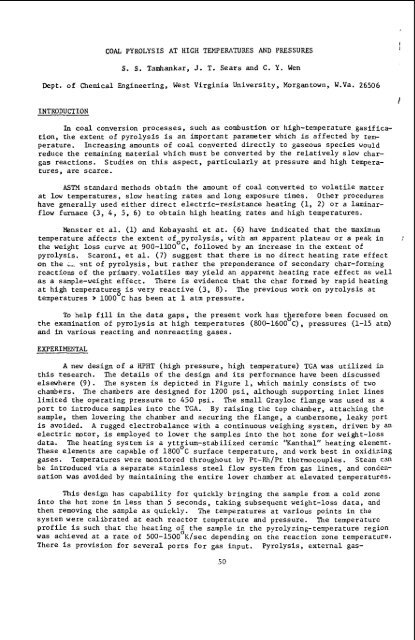the coking properties of coal at elevated pressures. - Argonne ...
the coking properties of coal at elevated pressures. - Argonne ...
the coking properties of coal at elevated pressures. - Argonne ...
You also want an ePaper? Increase the reach of your titles
YUMPU automatically turns print PDFs into web optimized ePapers that Google loves.
COAL PYROLYSIS AT HIGH TEMPERATURES AND PRESSURES<br />
S. S. Tamhankar, J. T. Sears and C. Y. Wen<br />
Dept. <strong>of</strong> Chemical Engineering, West Virginia University, Morgantown, W.Va. 26506<br />
INTRODUCTION<br />
In <strong>coal</strong> conversion processes, such as combustion or high-temper<strong>at</strong>ure gasifica-<br />
tion, <strong>the</strong> extent <strong>of</strong> pyrolysis is an important parameter which is affected by tem-<br />
per<strong>at</strong>ure. Increasing amounts <strong>of</strong> <strong>coal</strong> converted directly to gaseous species would<br />
reduce <strong>the</strong> remaining m<strong>at</strong>erial which must be converted by <strong>the</strong> rel<strong>at</strong>ively slow char-<br />
gas reactions. Studies on this aspect, particularly <strong>at</strong> pressure and high tempera-<br />
tures, are scarce.<br />
ASTM standard methods obtain <strong>the</strong> amount <strong>of</strong> <strong>coal</strong> converted to vol<strong>at</strong>ile m<strong>at</strong>ter<br />
<strong>at</strong> low temper<strong>at</strong>ures, slow he<strong>at</strong>ing r<strong>at</strong>es and long exposure times. O<strong>the</strong>r procedures<br />
have generally used ei<strong>the</strong>r direct electric-resistance he<strong>at</strong>ing (1, 2) or a laminar-<br />
flow furnace (3, 4, 5, 6) to obtain high he<strong>at</strong>ing r<strong>at</strong>es and high temper<strong>at</strong>ures.<br />
Menster et al. (1) and Kobayashi et <strong>at</strong>. (6) have indic<strong>at</strong>ed th<strong>at</strong> <strong>the</strong> maximum<br />
temper<strong>at</strong>ure affects <strong>the</strong> extent <strong>of</strong> pyrolysis, with an apparent pl<strong>at</strong>eau or a peak in<br />
<strong>the</strong> weight loss curve <strong>at</strong> 900-llOO°C, followed by an increase in <strong>the</strong> extent <strong>of</strong><br />
pyrolysis. Scaroni, et al. (7) suggest th<strong>at</strong> <strong>the</strong>re is no direct he<strong>at</strong>ing r<strong>at</strong>e effect<br />
on <strong>the</strong> L.- o-nt <strong>of</strong> pyrolysis, but ra<strong>the</strong>r <strong>the</strong> preponderance <strong>of</strong> secondary char-forming<br />
reactions <strong>of</strong> <strong>the</strong> primaryvol<strong>at</strong>iles may yield an apparent he<strong>at</strong>ing r<strong>at</strong>e effect as well<br />
as a sample-weight effect. There is evidence th<strong>at</strong> <strong>the</strong> char formed by rapid he<strong>at</strong>ing<br />
<strong>at</strong> high temper<strong>at</strong>ure: is very reactive (3, 8). The previous work on pyrolysis <strong>at</strong><br />
temper<strong>at</strong>ures > 1000 C has been <strong>at</strong> 1 <strong>at</strong>m pressure.<br />
To help fill in <strong>the</strong> d<strong>at</strong>a gaps, <strong>the</strong> present work has <strong>the</strong>refore been focused on<br />
<strong>the</strong> examin<strong>at</strong>ion <strong>of</strong> pyrolysis <strong>at</strong> high temper<strong>at</strong>ures (800-16OO0C), <strong>pressures</strong> (1-15 <strong>at</strong>m)<br />
and in various reacting and nonreacting gases.<br />
EXPERIMENTAL<br />
A new design <strong>of</strong> a HPHT (high pressure, high temper<strong>at</strong>ure) TGA was utilized in<br />
this research. The details <strong>of</strong> <strong>the</strong> design and its performance have been discussed<br />
elsewhere (9). The system is depicted in Figure 1, which mainly consists <strong>of</strong> two<br />
chambers. The chambers are designed for 1200 psi, although supporting inlet lines<br />
limited <strong>the</strong> oper<strong>at</strong>ing pressure to 450 psi. The small Grayloc flange was used as a<br />
port to introduce samples into <strong>the</strong> TGA. By raising <strong>the</strong> top chamber, <strong>at</strong>taching <strong>the</strong><br />
sample, <strong>the</strong>n lowering <strong>the</strong> chamber and securing <strong>the</strong> flange, a cumbersome, leaky port<br />
is avoided. A rugged electrobalance with a continuous weighing system, driven by an<br />
electric motor, is employed to lower <strong>the</strong> samples into <strong>the</strong> hot zone for weight-loss<br />
d<strong>at</strong>a. The he<strong>at</strong>ing system is a yttrium-stabilized ceramic "Kanthal" he<strong>at</strong>ing element.<br />
These elements are capable <strong>of</strong> 18OO0C surface temper<strong>at</strong>ure, and work best in oxidizing<br />
gases. Temper<strong>at</strong>ures were monitored throughout by Pt-Rh/Pt <strong>the</strong>rmocouples. Steam can<br />
be introduced via a separ<strong>at</strong>e stainless steel flow system from gas lines, and condens<strong>at</strong>ion<br />
was avoided by maintaining <strong>the</strong> entire lower chamber <strong>at</strong> elev<strong>at</strong>ed temper<strong>at</strong>ures.<br />
This design has capability for quickly bringing <strong>the</strong> sample from a cold zone<br />
into <strong>the</strong> hot zone in less than 5 seconds, taking subsequent weight-loss d<strong>at</strong>a, and<br />
<strong>the</strong>n removing <strong>the</strong> sample as quickly. The temper<strong>at</strong>ures <strong>at</strong> various points in <strong>the</strong><br />
system were calibr<strong>at</strong>ed <strong>at</strong> each reactor temper<strong>at</strong>ure and pressure. The temper<strong>at</strong>ure<br />
pr<strong>of</strong>ile is such th<strong>at</strong> <strong>the</strong> he<strong>at</strong>ing <strong>of</strong> <strong>the</strong> sample in <strong>the</strong> pyrolyzing-temper<strong>at</strong>ure region<br />
was achieved <strong>at</strong> a r<strong>at</strong>e <strong>of</strong> 500-1500°K/sec depending on <strong>the</strong> reaction zone temper<strong>at</strong>ure.<br />
There is provision for several ports for gas input. Pyrolysis, external gas-<br />
50<br />
I

















